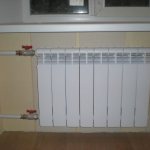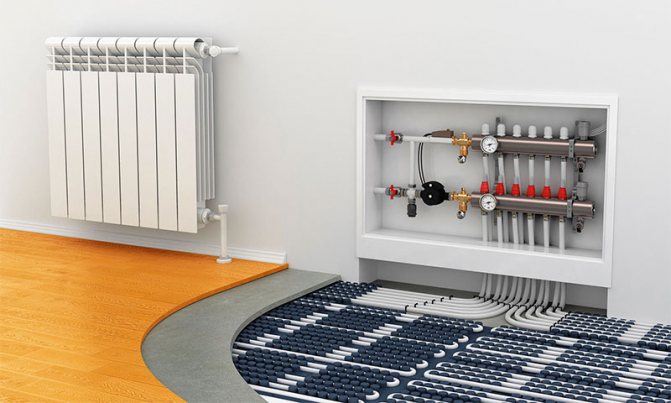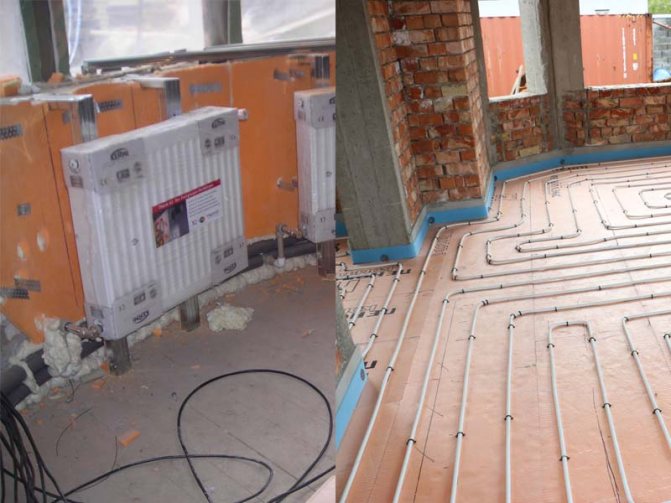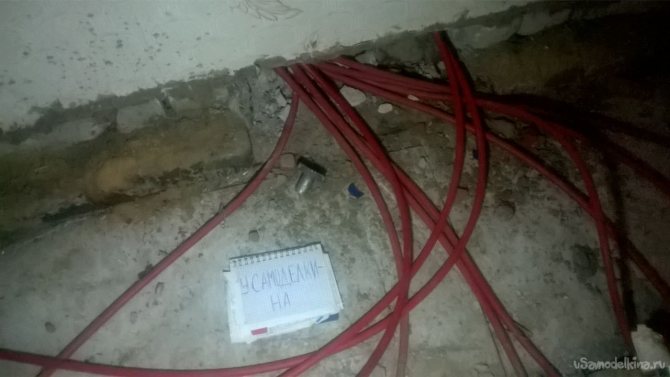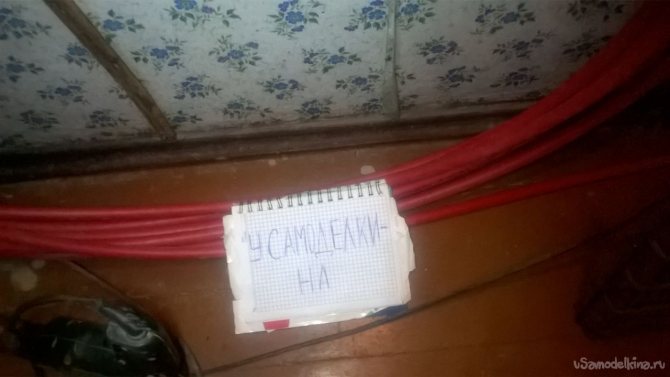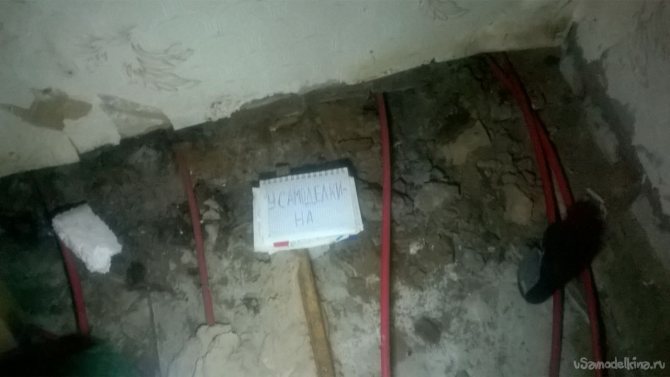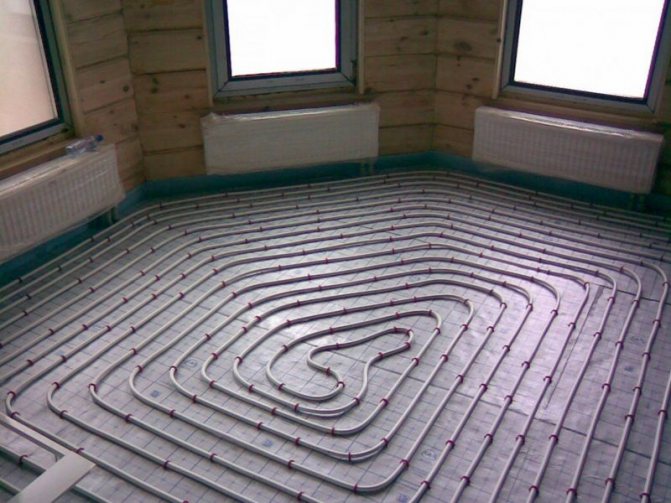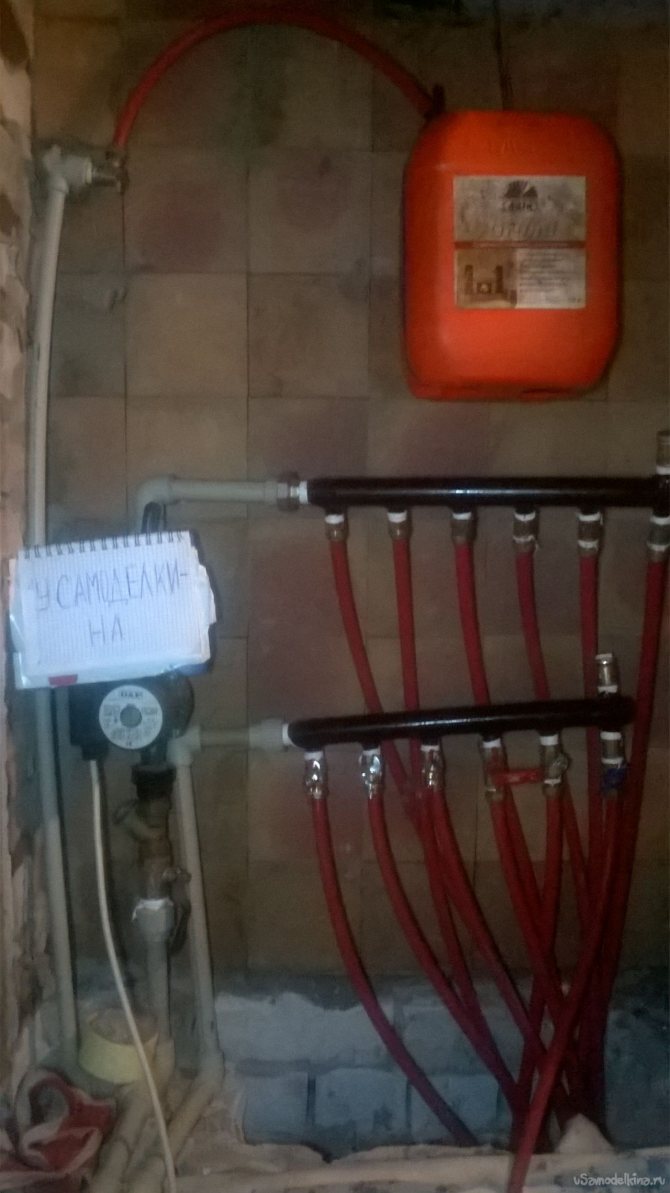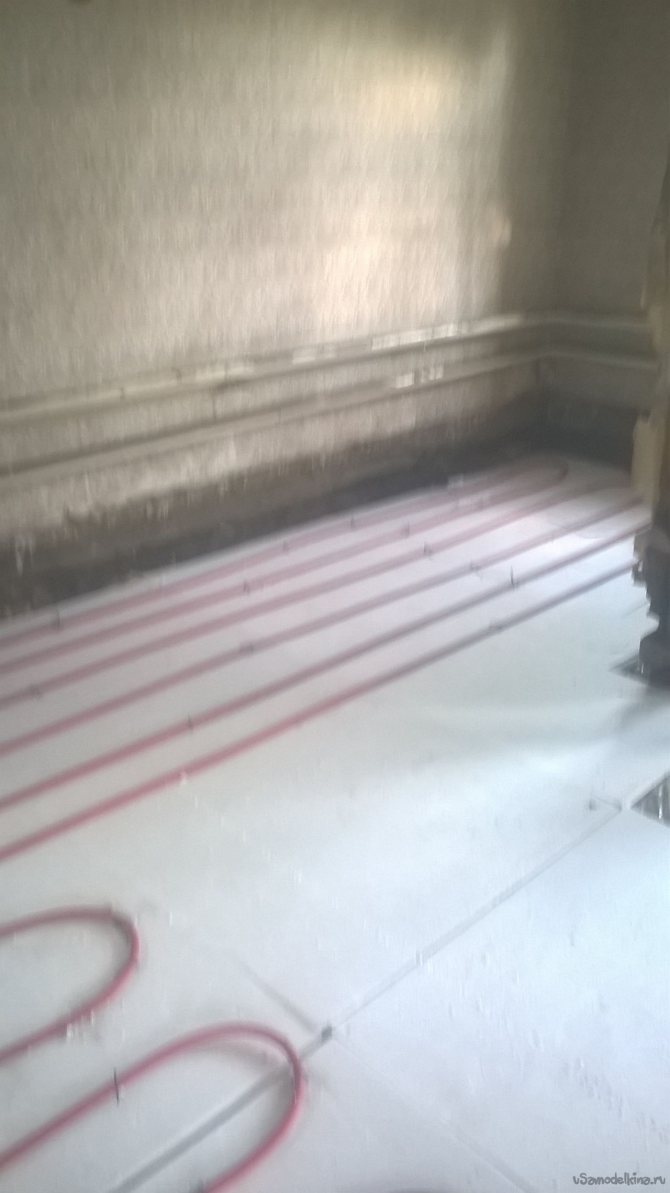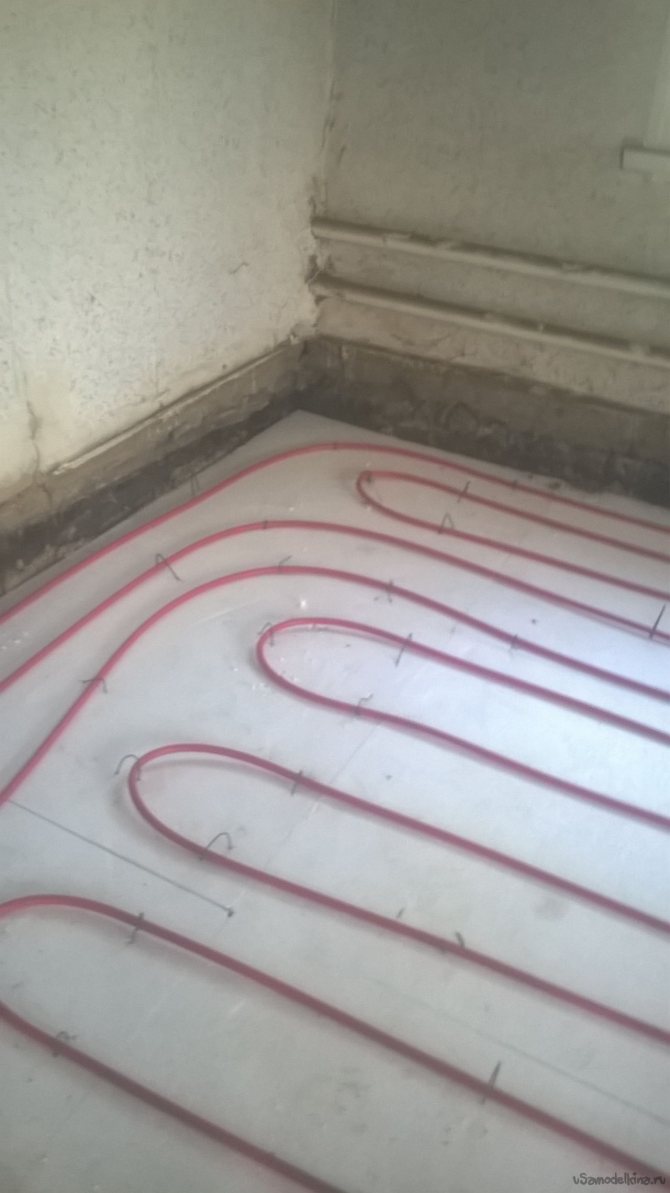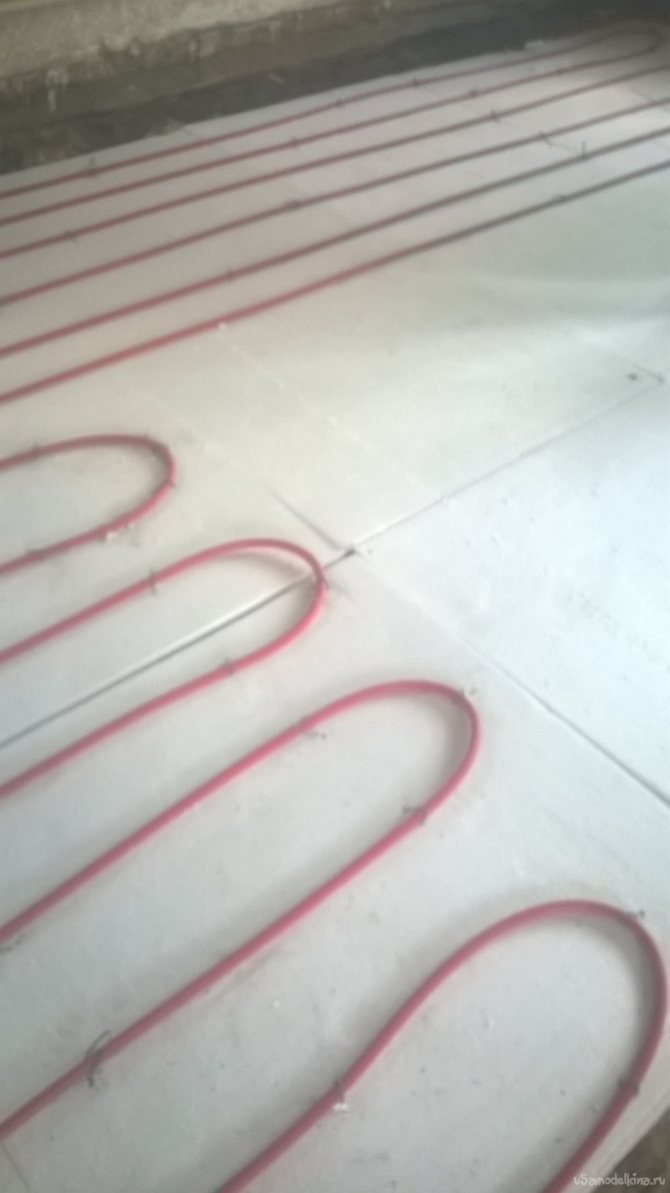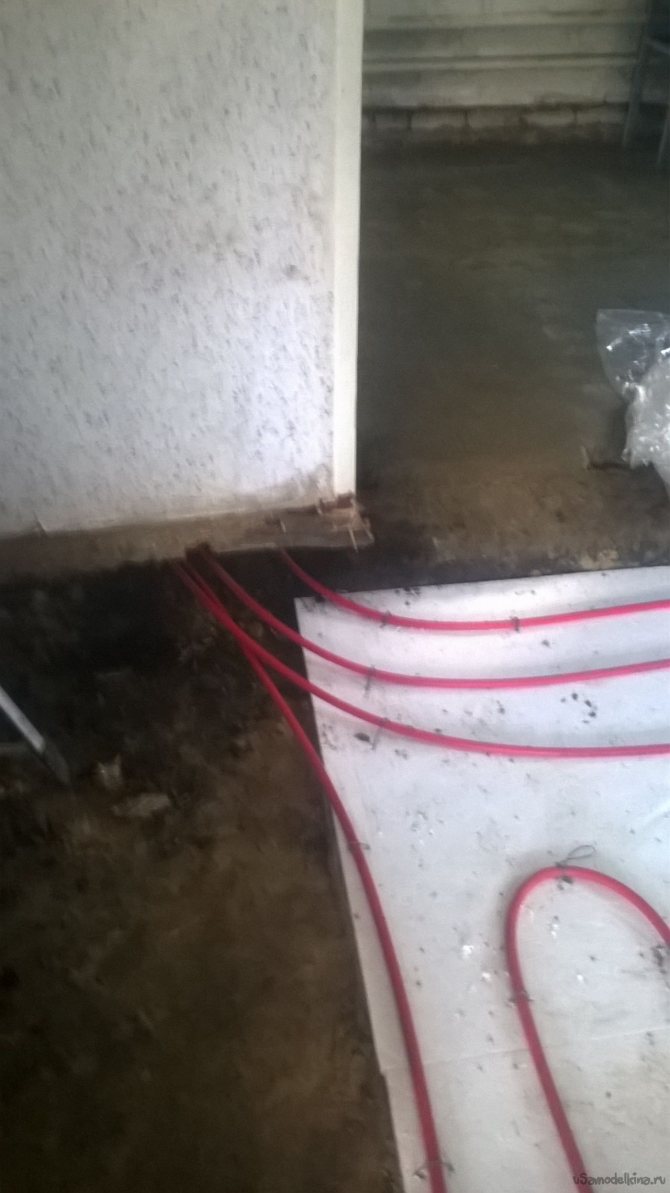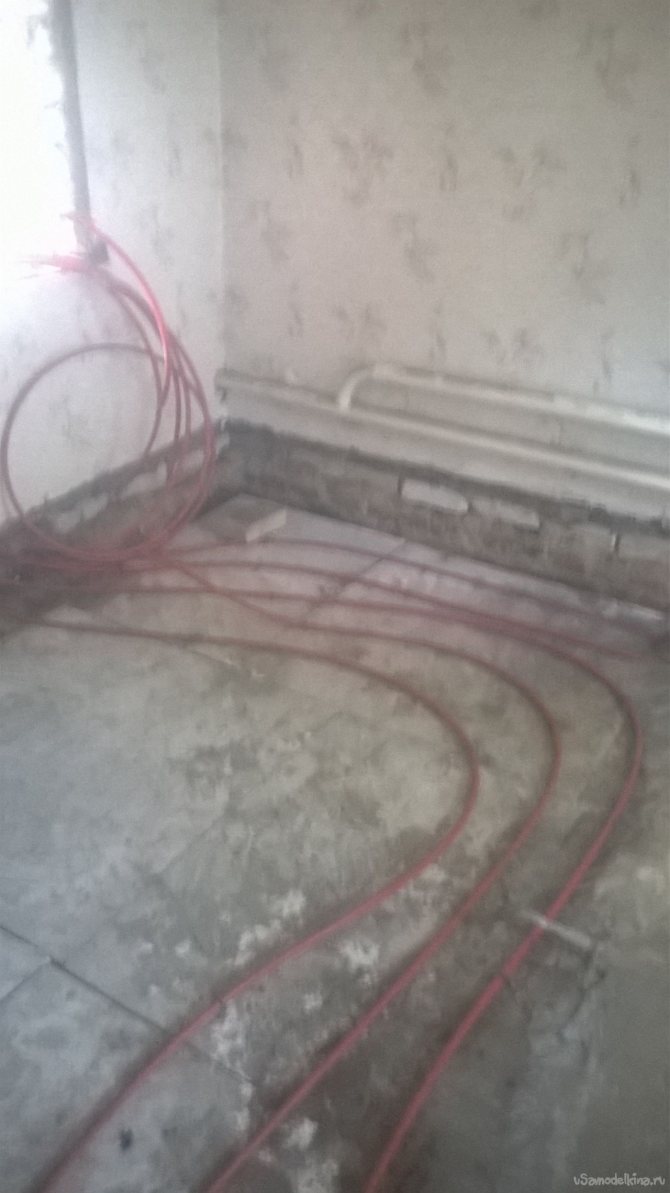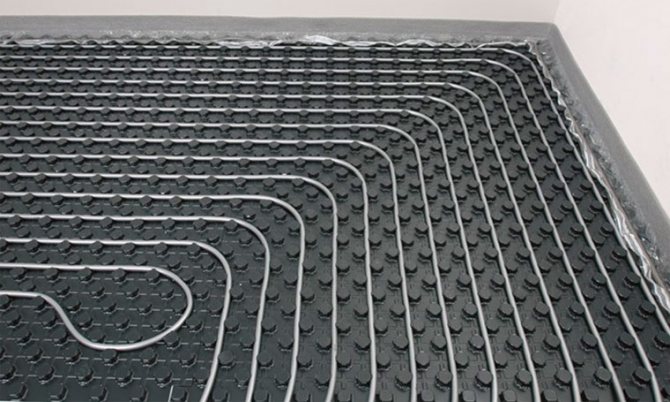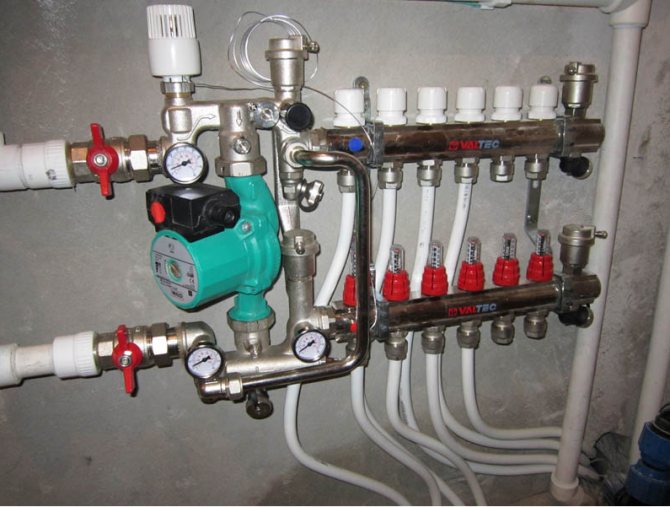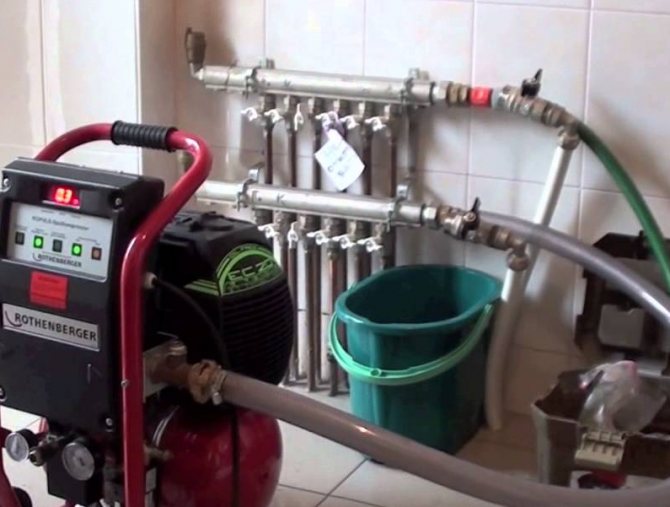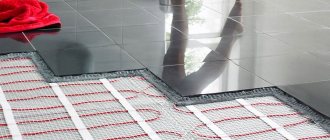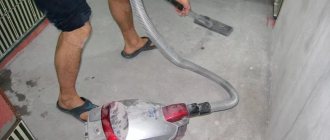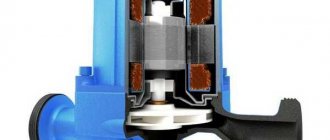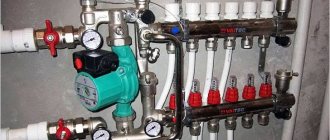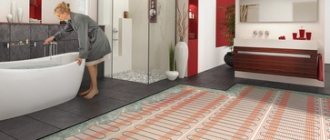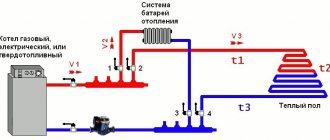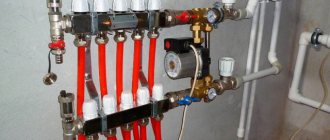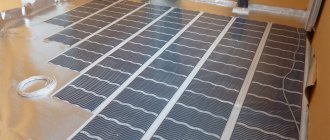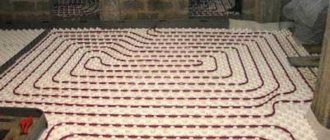An efficient and economical heating system is required for comfortable living in an apartment or private house. It must maintain the set temperature in the premises and be characterized by optimal consumption of thermal energy. The source of heat can be traditional hot water heating networks with radiators or underfloor heating systems. To understand which is more profitable, you need to evaluate the advantages and disadvantages of these heating methods. The comparison will also help you find out which batteries are better to use for heating an apartment and a private house.
Combined system
You can combine the two types of heating as follows:
- underfloor heating in addition to radiators;
- underfloor heating as the main source of heating, and radiators as an auxiliary one.
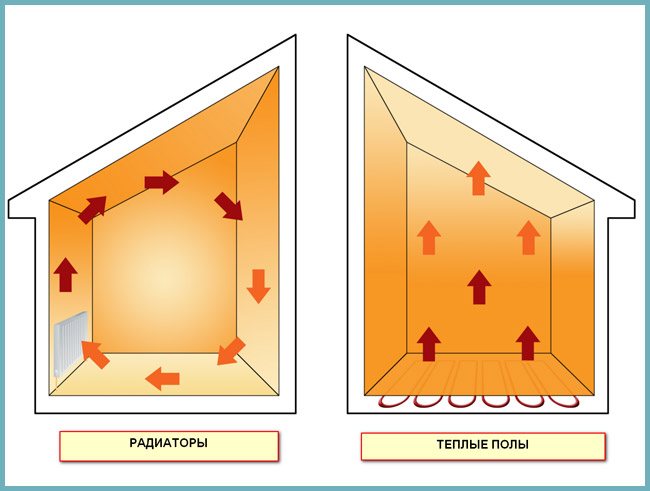
Air heating with a radiator and underfloor heating system
Often, to ensure comfort in two-story private houses, a warm floor on the ground floor is used as the main source of heating, and the upper floor or attic is heated with radiators. This combination allows you to take full advantage of the two systems. In the bedrooms you can adjust the temperature at night and during the day. And on the ground floor, the room warms up well.
If the heat loss of the room is large, then a combined system is arranged.
The combination of underfloor heating and radiators is a reasonable compromise
A warm floor usually suffices up to -7 - -10 ° C overboard, at lower temperatures it will not be able to compensate for all the heat loss of the room. And this is also provided that the house is well insulated. If the house is poorly insulated and heat loss is high, then these values are even lower - 0 - -5 ° C. But what to do at low temperatures? Here is the answer to the question: do you need radiators for underfloor heating. Yes, radiators combined with underfloor heating are the most efficient way to heat your home. We recommend using a floor heating system for comfort (that is, with a flow temperature of 15-25 ° C) as the main heating equipment, and radiator heating as an additional one.
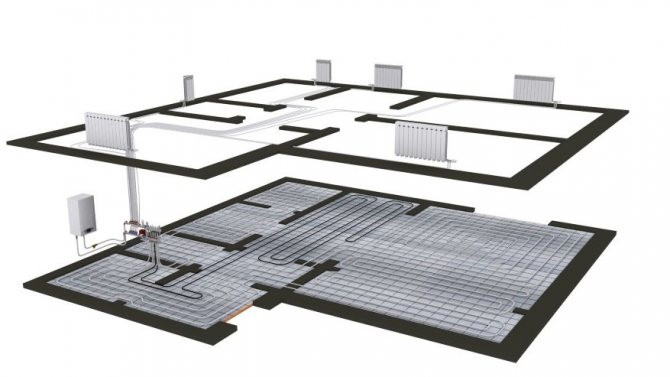

In this case, you get an efficient and economical heating system in which you will not feel discomfort due to the extremely hot floor surface. It is the combination of underfloor heating and radiators that is the solution most often chosen by Alter Air customers, since this is the most optimal option in terms of rationality and comfort.
The fundamental difference between underfloor heating and a boiler with radiator batteries
The main difference between underfloor heating and batteries is in the principle of operation. Underfloor heating contains heating elements that act on the ceiling, which heats the room. It warms up evenly, which means that people can walk barefoot and not be afraid of catching a cold. Heated air masses move upward, replacing cold, heavy masses moving downward.
The room is heated according to an inertial scheme - a concrete slab is heated, which further heats everything else. For those who do not like to wait a long time, it is better to stay on heating with a boiler, pipes and radiators.
But this is not such a serious feature to draw attention to, because in cold seasons, houses are heated around the clock.
“But the cold comes from the windows, radiators are installed in order to avoid these heat losses, and now everything is being removed from under the windows!” - the meticulous owner will say.Of course, this is so, therefore, small radiator batteries or so-called thermal paths are used together, which warm the window area and eliminate the fogging of the windows.
Are there any real savings when using underfloor heating?
But where can such savings come from if, theoretically, the same amount of heat should be spent to heat any room, regardless of the heating system?
When using underfloor heating, heat saving becomes possible due to the specifics of its distribution. When using radiator heating, the heat is constantly in motion - it rises up from the radiator, then cools at the ceiling and falls down to the floor, and when using a warm floor, there is practically no circulation, and the highest temperature is located at the very floor. In the underfloor heating system, the temperature of the coolant most often does not exceed 55 degrees, and in the radiator heating system, the temperature often reaches 90 degrees.
But don't jump to conclusions. The temperature difference between the heat carriers of the two systems under consideration is not in itself an indicator of savings. In order to maintain the same temperature in the room, the boiler in both cases consumes approximately the same amount of energy, in accordance with the elementary laws of physics. In this case, it becomes unclear where the savings can come from?
Comparison of systems from a technical point of view
Comfort
In your opinion, how is it more comfortable: when your feet are warm and your head is cool, or vice versa? Already based on the answer to this question, you can draw a conclusion for yourself: which is better - batteries or a warm floor. But this is only the first nuance when choosing, relying solely on it would be wrong.
Climatic conditions
If we take into account the peculiarities of the climate in our country, then the use of an exclusively warm floor for heating at low air temperatures will not be very comfortable. To fully heat an entire house or apartment in a harsh winter, you need to provide a high supply temperature to the warm floor. But in this case, you can forget about comfort - your feet will be hot. In addition, according to the norms (DBN V.2.5-67: 2013 Heating, ventilation and air conditioning)
the indicator of the most comfortable temperature of the "warm floor" - 26 C.
Note. This does not apply to an energy efficient home, in which heat loss is minimized as much as possible. In such a house, the underfloor heating system does not need a high supply temperature, so a comfortable underfloor heating is enough to fully heat the house in the coldest winter.
Heating radiators are devoid of such a drawback, but do not jump to conclusions. Alter Air focuses on the fact that it is the combination of underfloor heating and radiators that can give the most effective result in terms of comfort, convenience and efficiency of the heating system.
Don't feel like reading? Click on the button and engineers will provide all the information you need!
Appearance and the possibility of repair
It is necessary to install a warm floor once and it will work for a long time. In addition, you need to understand that underfloor heating is done only at the initial stage of building construction. It cannot be installed after repairs have been made in the house, since this system is poured with a concrete screed. Given these aspects, implementation must be approached with particular responsibility. In addition, when installing a warm floor, you need to select furniture with legs so that the distance between it and the floor is at least 10 cm.
The radiator can be removed, repaired or replaced. Installation of such equipment is much easier and less expensive.
As for the appearance, then underfloor heating is undoubtedly the leader. Whatever interior you choose, a warm floor will always be appropriate, because it is completely invisible.Radiators are always in sight, so you need to carefully select the model so that it blends harmoniously with the design of the room. In addition, radiators visually reduce free space, and in some cases this can be critical.
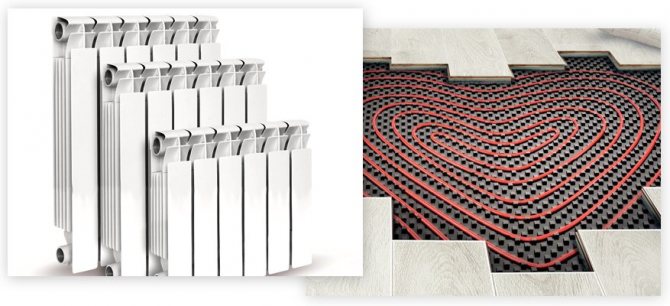

Battery types
Radiators are made from different materials. They are:
- cast iron;
- steel;
- aluminum.
Each metal has its own pros and cons, which must be considered when replacing.
Cast iron
They have a working pressure of 9 bar. As for other characteristics, they are as follows:
- height - 350-1500 mm;
- depth - 50-140 mm.
Such batteries, although they began to be used for a very long time, are still very popular. Their main advantages:
- relatively low price;
- the ability to add sections;
- durability;
- the ability to use with any coolant;
- high efficiency.
If we talk about the shortcomings, which must be taken into account when comparing, that it is better to have a warm floor or cast iron batteries, then they are also very significant:
- The room heats up for a long time after the batteries are turned on.
- The heat transfer of cast iron batteries is 110 W per section, which is quite small.
- You need a lot of coolant.
- These batteries weigh a lot.
- As a rule, the design does not differ in variety.
Aluminum and bimetallic
They appeared later than cast iron ones, but quickly gained popularity. Users appreciate:
- high heat transfer;
- ease of installation
- profitability;
- little weight.
In bimetallic batteries, most of these disadvantages have been eliminated.
Steel
There are two types of such batteries:
- panel;
- tubular.
The working pressure can be between 5 and 16 bar. Steel radiators give temperatures up to 120 ° C. Their dimensions may be as follows:
- height - 200-900 mm;
- depth - up to 225 mm.
Steel batteries are much more durable than others. They also have other advantages:
- high heat transfer;
- reliability;
- strength;
- low cost;
- easy installation;
- different connection options.
What is better water underfloor heating or radiators
Man is designed in such a way that he seeks to find the best possible solution at the best possible price. The heating system is no exception. Let's try to figure out which is all the same better: a system of water floors or radiator heating.
2. Distribution of heat. This is a clear advantage for water-heated floors. The radiator is often located in a localized location, under the windows, and the closer you get to the radiator, the warmer it is. On top of that, according to the principle of its operation, the radiator first heats the ceiling, and then the hot air flows down to the floor. Underfloor heating works differently. It is distributed over the entire area of the room and the temperature will be the same on each square meter of the floor. Plus, a warm floor warms up the room from the bottom up.
3. Temperature regulation. Both underfloor heating and heating radiators are adjustable, but the only difference is that radiators do it much faster. The reaction time is from 20 minutes to 1.5 hours, depending on what type of radiators you are installing. Aluminum and steel react much faster than bimetal and cast iron. And warm floors, in turn, react to temperature changes in just two hours.
4. Comfort. This criterion is quite subjective. But, as it was written earlier, the warm floor evenly distributes the heat. Due to this, it is more comfortable to be in a room with warm water floors. And moving on the warm floor, you do not feel the heating of the floors, because the surface of the warm floor is only 28 ° C.
5. Service life of the system. There is a rather controversial point here. Both those and other manufacturers assure that their systems are designed for 50 years of efficient operation. But taking into account that the system will be mounted correctly, there will be no overheating and other situations.We can observe the work of cast iron radiators installed during the construction of old houses. They have clearly served their time, and nothing happens to them. Unfortunately, the water floor heating does not have the same delayed result. Warm floors entered our market about 20-30 years ago, so their service life has not yet come to an end. But for all the years of service, nothing happened with warm floors.
6. Maintainability. Of course, in most cases it is easier to repair a radiator heating system. The radiator is the main device that generates heat. And if something suddenly happened to him: a section leaked, a crack appeared from a blow, you just buy a new radiator and replace it. With water heated floors, this is impossible. If it happens that you overheat the pipe in the screed, it will be much more difficult to repair everything. First, you will need to find the place of breakdown (rupture) of the pipe, and this often requires a thermal imager, which is not cheap. After that, you need to open the screed at the leak, dismantle the underfloor heating, and this is not only additional costs, but also dirt in the house.
7. Profitability. Installers like to say that heated water floors are 20-30% more economical than radiators. But, as practice shows, systems consume plus or minus the same. Of course, with additional costs for an air-conditioned gas boiler, you can save on heating when using the "warm floor" system. After all, such a system works when heated to 40-45 ° C, and radiator systems begin to work effectively only at 60-65 ° C. And if you take cast-iron batteries, then they need to be warmed up to 80 ° C so that they begin to give off heat. Therefore, at additional costs, a water-heated floor system will be more economical.
8. Aesthetics. The clear winner here is water heated floors for the reason that the entire system is hidden in the screed and does not take up extra space outside, unlike radiators. If you want to make a special design and put furniture in a certain place, nothing will hinder you. And radiators do not always fit into a modern interior. If you count, then the advantages of a water-heated floor are more. But this does not mean at all that the radiator heating system is worse. Both systems will cope with the heating of your home. But what it will be, it's up to you to choose.
How is radiator heating different from underfloor heating?
Before examining the prices for radiators and materials for underfloor heating, we will give a little theory to familiarize yourself with these types of heating. How is radiator heating different from underfloor heating? First of all, it is a method of heat transfer. Radiator heaters emit heat mainly by convection, that is, the movement of heated air. The warm floor transmits heat radiation, which is clearly less important in the case of radiators. The vertical distribution of temperature in heated interiors "through the floor" - from the point of view of human physiology - is close to ideal. We perceive the temperature as comfortable when the feet are at a temperature of 23-24 ° C, and higher it is colder.
Radiators are usually used to heat bedrooms, the floor in toilets, kitchens, hallways, living rooms. They have low inertia, which allows you to quickly heat the room and quickly reduce heating when it is no longer needed. In the case of a floor, the heating element is either liquid pipes or a heating cable in a concrete screed, and it takes 1-2 hours to change the temperature by 1 ° C. The fact that the floor heats up and cools down so slowly makes it difficult to control heating, but helps to keep the temperature inside stable. As you can see, the floor has not only advantages but also disadvantages.
Supporters of such heating emphasize that the absence of heaters contributes to the free arrangement of premises.This is not entirely true - you don’t need to worry about radiators, but when the floor has to be replaced, it should either not be covered with furniture at all or it should be covered with furniture with high legs for free heat release. There are also significant limitations when planning the flooring - the materials we choose must have good thermal conductivity. The best are ceramic and stone tiles, special wood paneling and flooring for heating, but you can forget about traditional parquet or thick carpets.
There is also a barrier to the thermal efficiency of underfloor heating. When the heating surface is small, the performance of the system may be too low. Underfloor heating can no longer be "regulated". It is assumed that the floor temperature should not exceed 29 ° C in the area of permanent residence of people (35 ° C is allowed in the edge areas of the floor) and 33 ° C in bathrooms. Therefore, in practice, most new homes use a mixed system: some rooms have underfloor heating circuits, others have heating appliances.
Underfloor heating installed in new houses can be water or electric, the latter are easier and cheaper to install in renovated ones. It should be remembered that the floor as an independent heating system will work only in buildings with low heat demand that meet modern thermal protection requirements.
Radiators are all clear and simple
With radiators, everything looks much easier. Having an autonomous heating boiler or central heating system, we ourselves determine how the pipeline will be installed and the heating devices connected. Two types of heating systems are commonly used, open and closed. In the first case, you will need to lay one highway, into which all the batteries available in the house will be connected in series.
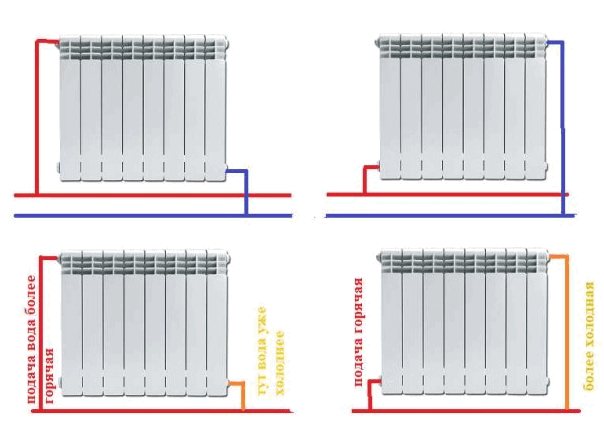

With an open heating system, you will have to lay two pipes, a supply line and a return line. In this case, the batteries are connected in parallel. This connection scheme is very convenient. You can always turn off one of the radiators, thereby reducing the load on the boiler and lowering the temperature in the room.
Of all you need to equip this heating option, the radiators are the most expensive component. These appliances, cast iron or steel, are quite expensive. However, in terms of operation, efficiency and durability, it is difficult to compare with them other materials. Bimetallic or aluminum radiators are cheaper, but inferior to cast iron batteries in efficiency and reliability.
New models are installed in new buildings, where in most cases there are autonomous gas boilers.
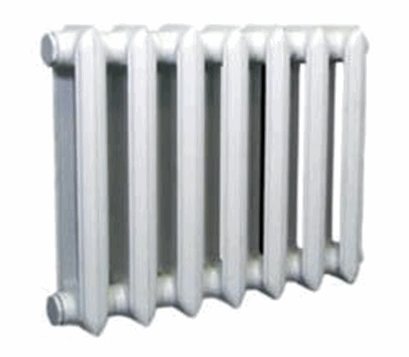

Disadvantages of conventional batteries (radiators)
Fortunately, radiators have far fewer disadvantages than advantages.
- The biggest of these is the unfavorable temperature distribution in the room. In contrast to underfloor heating, in a room heated by batteries, most of the warm air rises upward. Unfortunately, in this case, the heat is at the level of the head and above, and the coldest area in the room is on our feet, which does not contribute to comfort, but contributes to hardening. Of course, this is not the best solution in a house where there are small children who spend a lot of time not standing, but sitting on the floor. In this case, you will have to think about buying carpets or carpets.
- In addition, radiators do not contribute to the well-being of allergy sufferers. According to research, the phenomenon of convection, that is, an increase in air traffic, also increases the movement of dust particles, and with them, dust mites that are harmful to health.
- In addition, intense heating dries the air, which can lead to discomfort and drying out of the nasal mucosa.Therefore, in the autumn-winter period, dust purifiers and air humidifiers should be used, which will help to significantly reduce these problems.
- You also need to know that radiators can only work with high-temperature boilers and water heating systems. Underfloor heating, on the other hand, works with low-temperature heat sources, such as, for example, a condensing boiler, heat pumps and solar collectors.
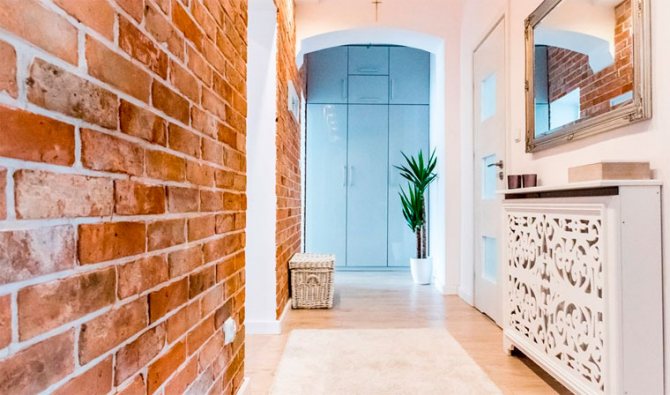

“There is no dispute about tastes,” says a well-known proverb. In the same way, there is no need to argue about which batteries or warm floors are better. For each of us, completely different solutions may be the best. In order to correctly choose which is better between batteries and warm floors, it is necessary to carefully analyze not only the advantages and disadvantages of both solutions, but also the financial possibilities. In addition, the type and nature, thermal insulation of the building, in which this or that heating system will be located, are important. Only a thorough, comprehensive analysis will help you make the right decision and enjoy the cozy atmosphere in winter.
Warm floor
A warm water floor is a concrete floor with a built-in piping system. This cake is laid on a cushion made of insulation. The heat from the floor is distributed evenly over the area of the room. Consider the advantages of this type of heating:
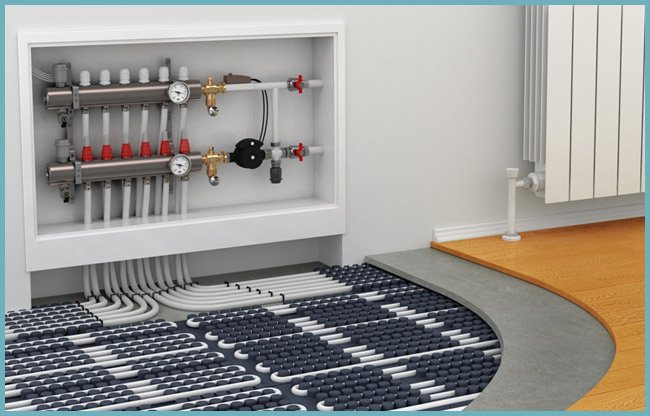

The disadvantages include complex and expensive repairs in the event of a leak, which is associated with the technology of laying the pipeline. Long heating and cooling of the floor. Small children get tired quickly, as their metabolism proceeds faster, the child will be constantly hot.
Advice. Installing an electronic thermostat will allow you to smoothly adjust the temperature in accordance with weather conditions.
Having weighed all the advantages and assessing the disadvantages, it is worth making the only correct decision in choosing a heating system for a private house. In any case, success is guaranteed by the correct calculation and installation, then the disadvantages will pass into the category of advantages.
Electric underfloor heating
Compared to a hydraulic floor, an electric floor has a number of advantages:
- can be laid in any room;
- no major repairs required;
- you can use the existing coating and you do not need to install an additional heat insulator;
- the floor height does not change;
- the room warms up quickly.
Heating elements are different. Depending on this, underfloor heating systems are divided into three types:
- wired;
- film;
- with carbon rods.
Wired
The wired option is more familiar and more understandable, but it has very significant drawbacks compared to the film one:
- consumes a lot of energy;
- is expensive;
- afraid of overheating, that is, you need to be extremely careful about the arrangement of furniture;
- creates electromagnetic fields around conductors;
- requires screed installation.
Film floor
It is more practical and more convenient than wired. Its main advantages include:
- low power consumption;
- lack of magnetic fields;
- can be installed without screed.
Carbon rod system
So far, this is the most modern version. It is quite rare, but it is necessary to know about the advantages and disadvantages. The advantages are as follows:
- the ability to independently regulate heat distribution;
- does not overheat, that is, the furniture can be placed as you like;
- does not consume too much electricity;
- fits under any coating.
Thermal management of electric floors
The electric unit that warms the floor can be adjusted, and the operation of the heating device is debugged. This is done by turning heating on and off, adjusting the temperature, and adjusting the repeatability of the process of turning on and off the thermal elements.


Thermostats for electric underfloor heating
The electric adjustable floor is controlled by special panels.They differ in appearance, in the place of installation, in the means of attachment and in the number of connected sensors.
Thanks to the control panel, energy is saved, it is possible to regulate the temperature regime without overheating.
The operating principle of the panels is special:
- electric underfloor heating is adjusted quite simply by an electronic-mechanical regulator with a meager set of functions. Manual wheel control like an iron. The wheel is connected to a constant temperature regulator. In this case, simplicity is the best solution both in terms of price and strength (rarely breaks, easily repaired);
- the digital control panel functions as an electronic mechanical regulator. The difference is that instead of a wheel, buttons or a sensor are arranged. The control unit is equipped with electric sensors that measure the overall temperature in the apartment and transmit this data to the thermostats;
- a modern part is the thermostat, which can be programmed. It contains several sensors for measuring temperature indicators. These sensors send information to the control device (controller). It is able to simultaneously maintain different temperatures in separate rooms;
- and the most modern regulators are controlled from the Internet. For example, leaving home, you can turn off the heating, and returning home, turn on the system from the phone. The floor will be warmed up by the time it arrives.
We recommend: What is included in the Valtek underfloor heating kit?
When choosing your option for a warm floor, it is recommended to take a closer look at the digital project. The advantages consist of ease of use, affordable prices.
In addition, the variety of design solutions contributes to the entry into the overall color of the apartment design. It is also important that the dimensions of the sensors and heating objects are combined.
What is better for a person a warm floor or radiators
But further we will talk about the most important thing - about thermal comfort. A person feels best indoors when his legs are warm, the middle part of his body feels moderately warm, and his head is relatively cool. It is according to this scheme that warm floors are distributed, but with a radiator heating system, the opposite will be true, that is, it will be cold below, and warm above.
According to research results, if you lower the average temperature in a room heated by warm floors, somewhere by 1-2 degrees, then a person will have about the same feeling of warmth as in the room that is heated by radiators and in which the average temperature did not change ...
Frankly speaking, this statement is absolutely true and is not a trick of marketers, so the benefits of underfloor heating are obvious. No calculations are needed to understand that it is much more important for a person to be warmer not in the upper, but in the lower half of the room. And here the question may arise, what will be the benefit in monetary terms?
Heating by radiators
Additionally, in order to understand which is more economical - underfloor heating or radiators, you should consider a more traditional type of heating. In this case, the information for reasoning will be much less.
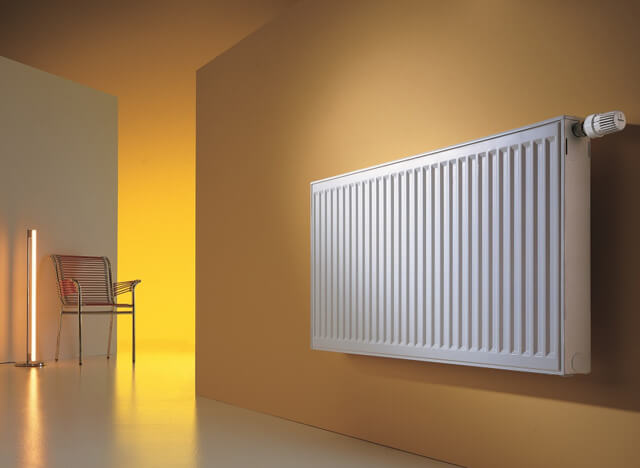

Perhaps it's worth starting with the disadvantages, which, of course, are available:
- Ineffective heating, which entails large financial costs, has already been mentioned above. Furious adherents of underfloor heating operate with this drawback.
- Installation of this type of heating implies strict control over pipe laying - it must be strictly horizontal.
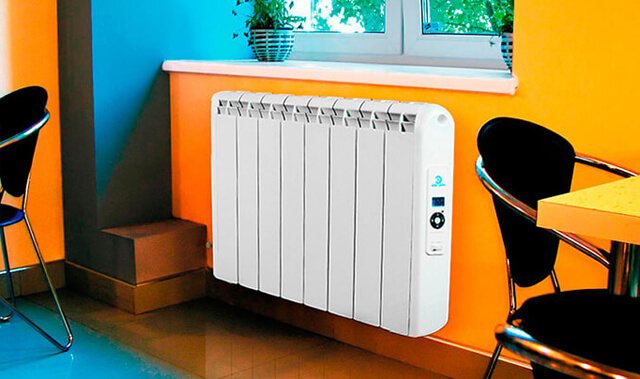

Of course, there are also advantages:
- Over the years, such a heating system has gained wide popularity, thanks to which it is now considered very affordable. In addition, due to many years of practice, radiators are not difficult to install.
- There is a huge selection on the market, both pipes and radiators, the execution of which can be of various materials. With a correctly installed system, it will be possible to turn off some of the radiators, if required in order to save money.
- With such heating, the air is not so much dehydrated.
Best Answers
Rost:
Everything is very simple! To understand which is better, you need to do the following: 1. You need to calculate the heat loss at home, knowing its shape, materials, etc. this is relatively easy to do, there are textbooks in the end. 2. Knowing the heat loss, you can choose the power of the boiler and the brand of radiators and their number, well, or the warm floor. When choosing, you will have to calculate how much heat the boiler will give, how much heat the house will receive through radiators or the floor. this is where it turns out which is best for your particular case. Without doing this, it is wrong to argue that it is better.
But, you can just make warm floors and everything, like everyone else, you will be warm and comfortable, did not hear that someone else was cold. Maximum hemorrhoids, this is possibly a higher fuel consumption than with radiators, and depending on which heating system. For bourgeois, for example, mainly low-temperature boilers, therefore, warm floors are popular with them, they give high efficiency at the same time, and in our country, like parvilo, they use high-temperature systems, in such systems the floors are not efficient in terms of fuel efficiency, the efficiency of floors is lower, i.e. Since the heat transfer of the floors does not correspond to the amount of heat that the boiler gives out (roughly speaking), the coolant does not have time to cool down significantly, since the warm floor consists of concrete, its thermal conductivity is much worse than that of metal. But if you forget about it, it will be quite comfortable. But in any case, it is most correct to make a calculation, and what to determine what is best and for what.
Pyih:
radiators - it is more convenient to change - warm floors - if correctly made - more economical.
Just Olga:
The radiator heats only the air, and the warm floor does not heat the air. If your apartment is cold, you need normal heating. To do this, buy good batteries or heaters. The warm floor is pleasant for your feet, you do not need a carpet and you can walk barefoot. Often it is made under the laminate or tile, which always remains cold.
Nadezhda Zhumatiy (Maslova):
When the floor is heated, warm air, rising up (the law of physics), heats up all the air in the room from the floor itself; at the same time, the walls must be very well insulated to avoid mold on them. Radiator heating warms up the area along the walls and windows. You can reduce heat loss by gluing specials on the walls behind the radiators. reflectors; in this case, some of the heat will pass to the center of the room. If there are no financial problems, it is better to do underfloor heating.
Arthur Zarembo:
If the heating system is low-temperature, with a heat carrier 40-45 deg. , then underfloor heating can give a good result in terms of comfort and energy saving. If the heating system is high-temperature up to 90 degrees. , then the use of underfloor heating entails increased energy consumption, it will be comfortable, but the energy consumption will be more than when using radiators. At high temperatures, the efficiency of the system on the radiators is better or higher. Gas costs money for the bourgeois, so they use low-temperature systems and underfloor heating, which is very economical and efficient. But, sellers do not delve into these nuances, and sell floors to everyone, stupidly translating bourgeois booklets in which gorgeous indicators are shown. This is a boman.
Natalia Terekhova:
Where are the floors? In the bathroom? The kitchen? Generally, radiators are used for heating. Warm floors are used in large kitchens and bathrooms, where there are exterior walls and tiles. In all other cases, these are unnecessary costs. Floors are not a substitute for heating. And by the way, this is a rather complicated redevelopment in legalization. IT cannot be legalized after rework. Until only after the project has been approved by all the rules.
Andrew:
Try to make a warm floor, it is better than radiators in all respects, except for the initial investment.
Avanez Kirpikin:
What is better depends on the design of the house and the heating system. Comparing a radiator and a warm floor is stupid in principle. Warm floor is, roughly speaking, a radiator wrapped in a fur coat. It works in a completely different way. It can be done well both on radiators and underfloor heating. Although underfloor heating is often not enough, it depends on the region and the heating system. Before you do something, figure out what and how. As for the best indicators, about which the previous speaker speaks, it is worth clarifying under what conditions they are obtained, and what kind of indicators are they, what are they called, what parameters or numbers have?
Which heaters to choose?
For a new home, the power and type of radiators are predetermined by the design. You can, of course, choose the ones that you like from an aesthetic point of view, but the installer should still check if they are suitable - because of the capacity, size, location of the connections. Heaters can have a bottom or side connection. They are selected depending on whether the installation pipes are laid in floors or walls. The type of material the pipes are made of is also important.
It is worth paying attention to whether the radiators are easy to clean and whether they are dangerous for children - beware of sharp edges! They are installed where heat loss is greatest, that is, most often under windows and external doors. Some weigh several tens of kilograms, so it is important that they are securely attached to the wall. If this is not possible, select a model on the floor. They are connected to the installation using valves that regulate the flow and shut off in response. The control valve is adapted to fit the thermostatic head. Radiators can work with any heat source.
Plate radiator with smooth front panel
The most popular are panel radiators - with a smooth surface, available in different types, sizes and colors. They are made of sheet steel that is corrosive. The plate models consist of one, two or three burners (they are the thickest and have the greatest power), they are covered on top with a grate through which hot air comes out. The front panel can be flat or profiled and fins can appear in the heatsink increasing power (and making it difficult to clean). Plate radiators have a small capacity and quickly respond to changes in heat demand.
Articulated radiator
The power of articulated radiators can be easily increased by adding more fins. Articulated radiators are made up of repeating elements (fins) combined in kits of any length. They are made of aluminum or cast iron, so they are corrosion resistant. Aluminum radiators are lightweight, but prone to mechanical damage. They are usually chosen when upgrading a heating system in place of older fin, steel or cast iron models.
Cast iron radiators are back in fashion - they are preferred by lovers of retro-style interiors. They are the most durable, keep warm for a long time, and the models produced today warm up faster. The big advantage of articulated radiators is the ease of changing their heating power - just add or remove a few fins.
Convector heaters
Convector heater - the heating element is an invisible heater, the body has only a protective function. In convector heaters, the heating element is a loop heater. It is covered with a casing that has no heating function, but only a protective function. They are distinguished by the fact that they transfer almost all heat (up to 95%) by convection. Convectors are lightweight, heat up the fastest, and can be small in size.However, they cause intense air movement, which contributes to the movement of dust in the house. The temperature distribution in the interiors heated by them is not very favorable - warm air accumulates under the ceiling, and cool air near the floor.
Duct heaters
A variety of convector heaters are duct heaters, which are installed in channels made in the floor and covered with openwork screens - they are invisible, like the floor. They are usually planned along large windows above the floor. They allow you to divide the heated space - they act as air curtains and effectively protect against the influx of cold from terraces or balconies. Their installation, however, must be considered during the manufacturing phase of the floor underlayment.
Decorative radiators
Decorative radiators combine heating function with decorative one. They come in a wide variety of shapes, and can resemble a sculpture, a painting, or a heating wall that divides a bathroom. This is a hanger or bench. This group also includes tubular bathroom radiators in the form of a staircase. Most often they are made of steel, and pipes can have different cross-sections, not only round but, for example, square. Towel warmers are easy to keep clean. They can be equipped with an electric heater so that wet items can be dried outside the heating season.
Radiator heating costs
We'll spend on steel panel white radiators from $ 10 (small) to $ 100-500 (for the large 60cm high, 110cm wide, 10cm deep). The color surcharge is 1/3 of the price. Aluminum hinged radiators start at $ 70 (10 fins), cast iron radiators are more expensive - their prices start at $ 70 (for the smallest) and go up to 300-400 for large ones. They are also disassembled and sold for ribs - the cost of one rib is 20-50 dollars.
Connection valves and thermostatic head cost from 20 to 50 USD. To install a radiator, plumbers take from $ 100 in equivalent, the approach to a radiator from plastic pipes is from 20 to 30 USD, from copper - about 60 USD.
Water heating with underfloor heating using pipes
In this system, heat is transferred through pipes located in the floor through which heated water flows. Reinforced-plastic pipes (usually multilayer with an aluminum insert) are embedded in a floor screed layer with a thickness of at least 6 cm. They must be strong, corrosion-resistant and impermeable to oxygen. In copper installations, soft pipes are used, which can be of arbitrary shape. They must be covered with a plastic sheath. The beginning and end of each pipe are connected to collectors located in special cabinets.
Pipes are laid on thermal insulation - expanded polystyrene, mineral wool, polyurethane boards - and moisture insulation made of polyethylene film. Pipes should be 15 cm apart, maximum 30 cm apart, and in edge areas, such as near windows, their density should be higher. The principle of forming heating loops from one pipe section without fittings must be observed. The designer defines the diameter of the pipes, their distance and the length of the heating circuits.
The water floor works best with modern low-temperature sources of thermal energy - heat pumps, condensing boilers. They produce heat less expensively than traditional heating appliances, but they are more expensive.
Heating costs with a water floor
The price per square meter of a water-heated floor (materials and work) ranges from 100 to 200 USD. Its height is influenced, for example, by the use of additional room thermostats. Multilayer pipes (16-20 mm in diameter) cost from 2 to 6 USD per linear meter, copper pipes are several times more expensive.
Installation work costs at least 30 USD / m2.A water floor should not be built in small areas, because the price here mainly depends on the hydraulic fittings, which you will buy anyway, regardless of the area. A reasonable area for heating with water-heated floors is at least several tens of m2. When connecting it to a radiator system, it is necessary to take into account the costs of automating the processing of the circuit using a mixer or pump unit - a distributor with a mixing system costs from 300 USD.
Underfloor electric heating
Such electric heating is mainly used in refurbished buildings where replacing radiators with water floors is difficult and expensive. However, with the reduction in the cost of equipment, some even medium-sized country houses are heated exclusively by electric underfloor heating. Electrical equipment can be installed even when the tiles are replaced. In this system, heat is radiated by heating wires, or heating film, through which current flows. The required temperature is set by thermostats. The cables are laid in a 5 cm thick screed.
The cable can be laid on the fiberglass mesh in the form of mats (usually 50 cm wide), which facilitates the laying process and allows them to be laid in an adhesive layer directly under the ceramic tiles or panels. Underfloor heating elements transfer heat faster, so the heating does not have much inertia.
Heating cables
Heating cables are laid under the floor, in an adhesive layer or in a self-leveling compound. Electric heating cables for underfloor heating can be conventional (with constant resistance), that is, heated with a constant power or so-called self-regulating. The first one should not be placed in places where it is difficult to receive heat, for example, under furniture, a thick carpet. Self-regulation is the best option. Even different sections of the same cable get hotter or weaker depending on the ambient temperature. The only drawback of self-regulating cables is their price, which is 3-5 times higher than that of a conventional cable
To install electric underfloor heating, you only need cables or heating mats, holders for fastening them and simple thermostats. You don't need a boiler or other heat source, boiler room or chimney. Electrical wires are more expensive than pipes, but they are easier and cheaper to install. In a small bathroom, you can install them yourself.
Floor heating costs
A complete set of electric heating (heating mat 160 W / m2, regulator, floor temperature sensor, mounting accessories) costs, depending on the area, warranty and manufacturer, from $ 25 (1 m2) to $ 1000 (15 m2). We pay for self-regulating heating cables from 5 USD / m. linear. When heating 1 m2, we need about 6 meters or 35 USD. A simple mechanical thermostat costs about $ 20, a programmable one costs about $ 50. Cables are used less frequently, and the mats that are easiest to install prevail on the market.
When calculating the material and labor per 1 m2 of heated floor surface, it turns out that the cost of materials and the installation of an electric floor heating starts from $ 35 per square meter, and with more expensive, so-called "European" equipment, it can even be 3 times higher ...
Instead of a conclusion
If we compare heating with radiators and underfloor heating, then we must admit that radiators will cost much more expensive electric underfloor heating and about one and a half times cheaper than water underfloor heating. It makes no sense to install them in small areas. To do this, it is best to buy underfloor heating in the form of heating cables, mats or infrared film. In this case, the cost of heating 1 "square" will cost you about $ 35 against $ 100-150 for water heating with radiators or water floors.However, for large areas, it will be more optimal to purchase all equipment for hot water heating, which will pay for itself in 2-3 years due to cheaper gas fuel compared to electric fuel.
Installation of electric underfloor heating
The installation of cable and infrared systems is, of course, somewhat different. At the same time, cable systems are divided into two types:
- actually cable;
- cable in a reinforcing mesh.
In addition to the system itself to be mounted, you need:
- mounting wire;
- grounding cable;
- fasteners;
- regulator;
- thermal sensor;
- RCD system.
As in the case of a hydraulic floor, the first step is to prepare the room - to level the surface and lay a layer of thermal insulation and vapor barrier. The infrared floor just needs to be spread over the surface and attached with tape.
- Install a layer of heat reflector.
- Measure the resistance of the heating cables - this must be done before laying.
- Compare the discrepancy with the data in the passport - it should not be more than 10%.
- Lay the cable and secure.
- If you need concrete pouring, lay a reinforcing mesh.
- Connect the power cable and heating element.
- Lay the cable in a corrugation.
- Attach the corrugation to the floor.
- Check the resistance again.
- Pour screed or tile.
Pour coolant into the system. How is this done?
Let's start with the fact that underfloor heating is a specific heating system. At the first contact with such equipment, an uninitiated person has a lot of questions about this. Basically, consumers are concerned about issues related not only to the installation of equipment, but also to the first start-up and subsequent operation of the warm floor. As is the case with traditional heating equipment, underfloor heating needs to be crimped. The system needs periodic cleaning and draining of the coolant. The first start-up of heating is already the last step, after which you will have to deal directly with the maintenance of all heating equipment, taking into account all technological features, subtleties and nuances.
Each heating system has its own technological methods and options for supplying the coolant to the heating circuit. In the event that you use ordinary tap water as a heat carrier, you must have a special tap that supplies tap water to the water circuit.
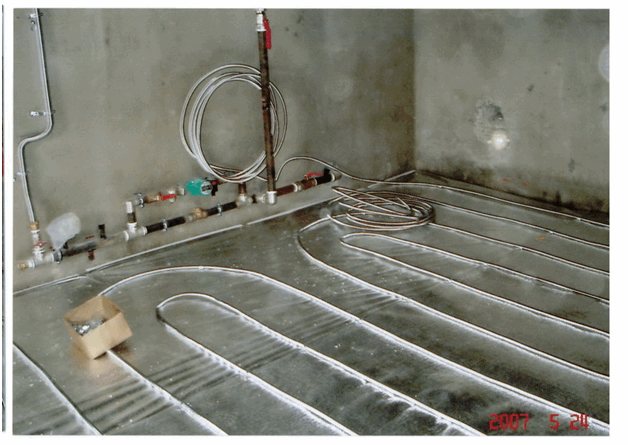

The use of other liquids for heating requires the installation of a special tip equipped with a shut-off valve in the supply part of the collector. It is through this valve that the device is connected for crimping the future heating system. With the help of this device, antifreeze or a special solution is usually poured into the heating circuit.
For reference: the devices used for pressure testing are suitable for filling heat transfer fluids based on glycol and its derivatives. As a rule, automatic and manual units are used. It is not necessary to buy it. Today, many hardware and specialty stores offer similar equipment for rent.
If water is used as a heat carrier, then such a device will come in handy on the farm. The water in the heating system must be changed at least once a year. Drainage of water from the warm floor is carried out in this case according to a certain technology. The main condition is the presence of a drain valve on the return manifold for each water circuit.
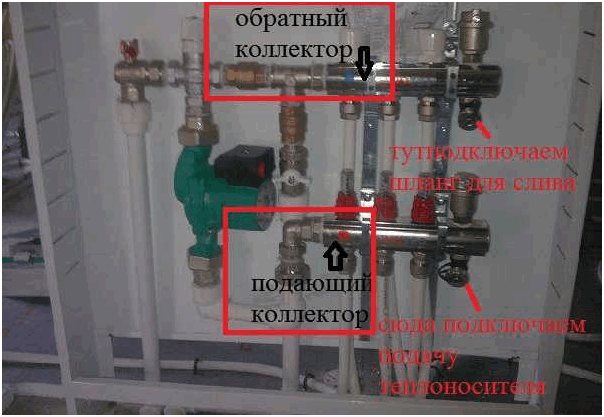

Depending on the location of the collector, how the return and inlet part of the collector is located, new coolant is fed into the supply pipe (red) through a shut-off valve.
Consider the algorithm of actions when pouring a coolant:
- the water circuit is flushed with running water before filling the coolant. A similar procedure will eliminate the remnants of assembly debris and lubrication elements from the channel.In this case, the system is flushed several times with water until clean water flows through the return;
- flushing the heating circuit for a water underfloor heating is necessary every time the coolant is changed;
- before pouring the coolant into the system, ordinary water needs to be prepared. If the region has hard water, rich in calcium salt impurities, soda ash is added to the solution to soften the water;
- when working with antifreeze, especially grades containing ethylene glycol, special precautions must be taken.
Important! It should be remembered that antifreezes made on the basis of ethylene glycol are poisonous substances, contact with which can result in serious poisoning. Under no circumstances should the hoses and pipes of the heating circuit be blown out with your mouth if there were previously chemicals and liquids there.
Warm water floor. Installation and main features
You still doubt the choice. What is better, to dwell on radiators or to start preparing the installation of underfloor heating. Just estimate the amount of materials, equipment required and the level of work in each case. This will immediately give you answers to many questions, leave heating radiators or rely on underfloor heating.
First, you need to understand what the main stages of the installation of warm floors are. Why start with this heating option? The thing is that this method is considered newer and less studied for most consumers.
installation of warm water floors is best done in a new building, when finishing work has not yet begun, and instead of the floor there are simple concrete floors. We take into account the fact that with water circuits laid in the floor, the ceiling height in heated rooms will decrease by 100-150 mm. For a private house, this does not pose a problem, while for a city apartment, it sometimes becomes critical.
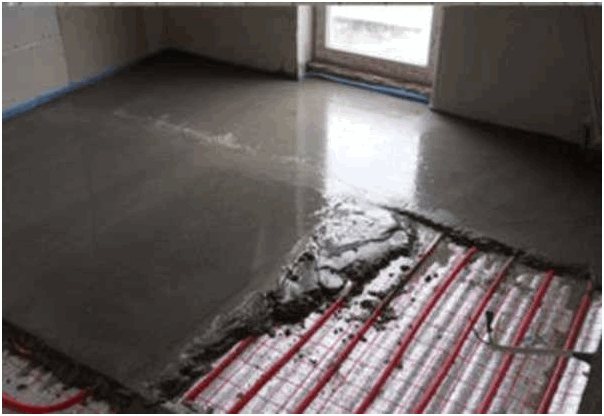

basic installation is as follows. A surface is prepared on which a layer of thermal and waterproofing is laid. Next comes the mesh or special mats, on which the water pipes of the heating circuit are laid. As a result, your floor looks like a puff pastry. This design is called a puff cake, in which each layer plays its own, definite role.
Before concrete wet works, a damper tape is glued around the perimeter of the room, playing the role of a compensator for the thermal expansion of the concrete surface. The water pipe is laid in two patterns, a snake or a spiral. Depending on the intensity of heating, you yourself choose the installation scheme.
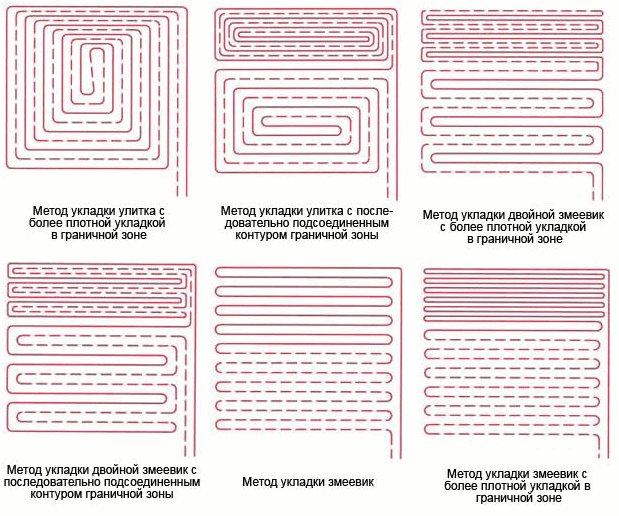

only after connecting the water circuits to the distribution equipment (pumping and mixing unit), a test run is carried out. If no flaws are found in the technical part of the system, there are no leaks and the heating is in accordance with the specified parameters, you can start laying the concrete screed.
Heating by the type of underfloor heating without radiators is usually chosen when there is a powerful autonomous heating boiler of high power. In a house where constant heating is required, there is a constant consumption of hot water; underfloor heating must work without interruption. It is due to the powerful boiler that the required heating rate of the coolant and the flow rate that meets the technological parameters are achieved.
Combined system - expert opinion
You can combine heating with radiators and underfloor heating. In many cases, this will be more convenient and economical for several reasons.
If you have a two-story house or apartment, then it makes sense to make warm floors on the first floor, and install radiators on the second and subsequent ones. The heated air from the first floor will warm up the floors between it and the second. As a result, the heating of the upper floor does not require large heating costs.
The operating temperature of the water-heated floor is 30-35 ° C, and of the radiators 55-90 degrees.You can make an interesting connection diagram for underfloor heating and radiators. In simple words, let the water first through the radiators, and then, cooled down, onto the warm floor. How to implement all this - see the diagram.
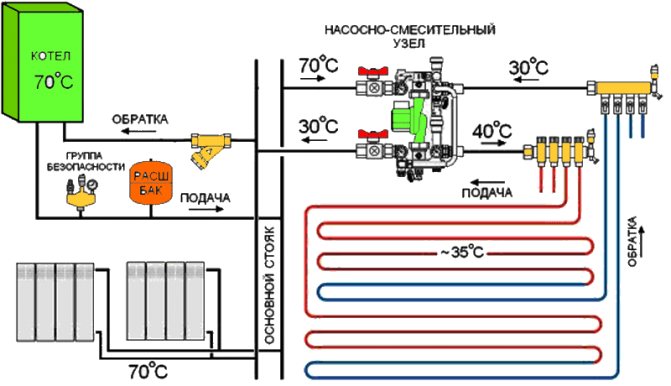

Connection diagram for underfloor heating and radiators in one system.
In a one-story house or apartment, it makes sense to make separate radiators and heated floors. Agree, when you get out of the shower, it is much more pleasant to step with bare feet on a heated tile, and not on a cold one?
Radiators
The advantage of the classical method is the low cost of installation compared to a warm floor. And the main disadvantage is the uneven distribution of heat. Much depends on the type of radiator and the way it is connected. The coolant of an effective battery is about 70 degrees. It is the high temperature that allows the radiator to have compact dimensions. The lower the temperature of the coolant, the more radiators are required to heat one room. What are the other advantages and disadvantages of the classics:
the radiator and heating pipes are always in sight, which affects the interior design;
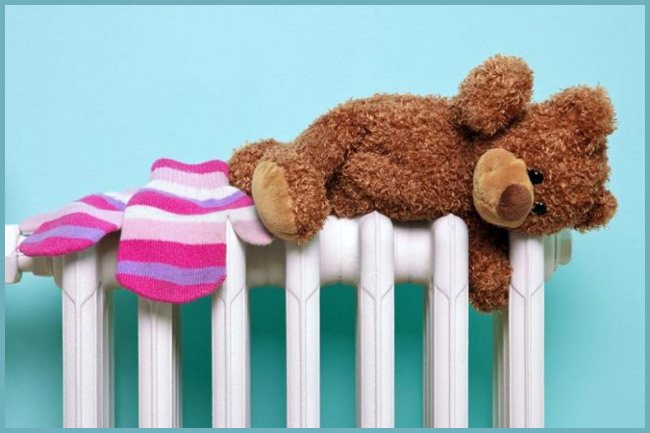

- the performance of the radiator is easily regulated by the thermostatic head, the temperature change will occur within an hour, while in the underfloor heating system you will have to wait several hours;
- due to the fact that the entire system is in sight, it is easy to repair it, to replace some elements with more efficient ones. Underfloor heating is installed in a concrete screed once and for all;
- finned radiators give off heat by convection by 80%, the rest is radiation;
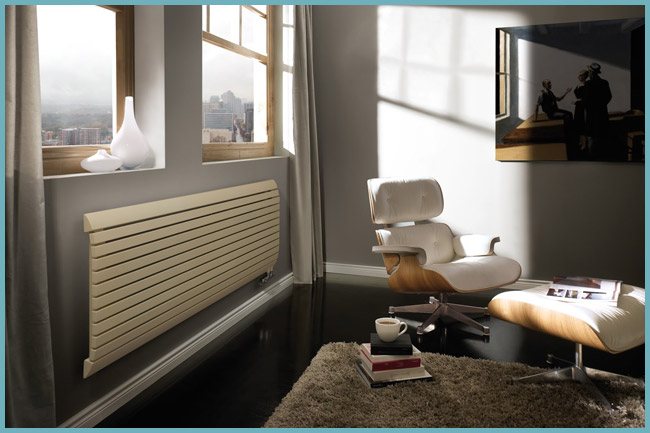

Finned radiators in the interior
- convectors transfer heat by convection, which leads to an increased circulation of dust in the room;
- aluminum radiators emit only 8% of heat, the rest is convection;
- panel radiators emit 35%, the rest is convection.
Materials, equipment and procedure for draining water
To do the work you need, you need a compressor, with a good performance, with a receiver for accumulating compressed air.
As you already understood, the automobile will not work for these purposes.
If you plan to drain the spent antifreeze, then you yourself understand that it is not necessary to drain it where it is not necessary.
You will also need clamps of the correct size for a secure hose connection.
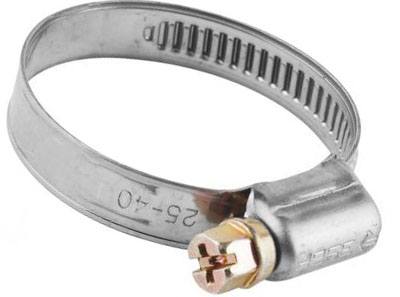

Connect the hose from the compressor to the underfloor heating supply manifold.
The supply manifold may or may not have a special fitting for filling the system under the hose. Therefore, the automatic air vent valve is unscrewed on the feed comb and a hose is connected through a suitable adapter and tightened with a clamp.
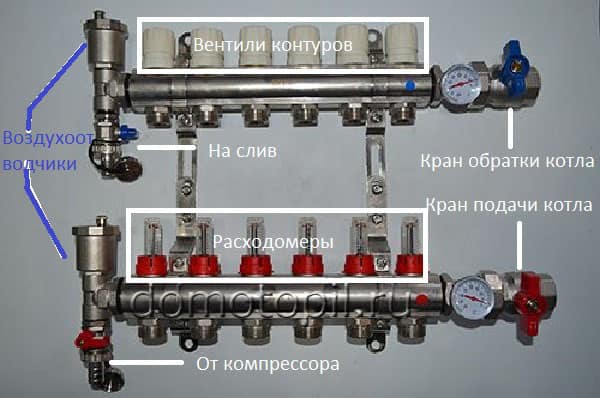

Arrangement of elements on the manifold for draining
- Connect the hose to the return manifold in the same way and lead it to the drain.
- Close the supply and return valves coming from the boiler in the collector area.
- Using flow meters or valves (depending on your collector), close all the underfloor heating circuits, except for one, which, on the contrary, needs to be opened to the maximum.
- Turn on the compressor, open the taps or tap (depending on the type of comb), which are intended for filling and draining the system (those on which the hoses are worn). At this moment, the coolant will begin to flow out under pressure from the drain hose. Wait until the water runs out and air flows. At this point, look at the pressure gauge on the compressor. If the pressure in the receiver at this moment is not high (1-3 atm.), Then close one of the taps on which the hose is fitted (it is desirable that it was a tap on the supply manifold, or if the pump is equipped with its own shut-off device, use it better) ... Wait for the pressure to rise to 5 atm. (no more) and blow the floor loop under this pressure.
- Close the blown loop and open the next one. Repeat the same procedure with him.
- Thus, drain the water from all the contours of the underfloor heating.
- For best efficiency, repeat the procedure after half an hour, as the remaining water droplets in the pipe may interconnect and eventually overlap the pipe section at a certain point.
Adhering to this method, you will decide the question of how to drain the water from the warm floor. The only problem is getting a compressor that can handle the task.
Self-pressure testing of the underfloor heating system
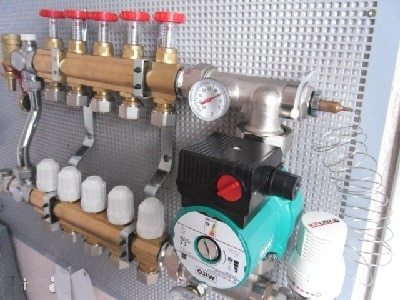

The first launch of a warm water floor
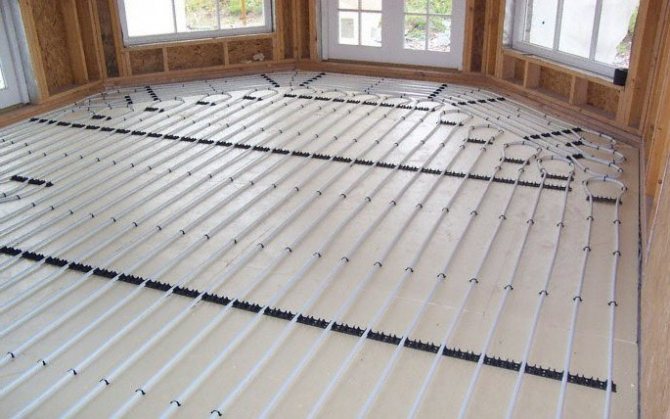

Rules for installing a warm water floor based on a concrete screed
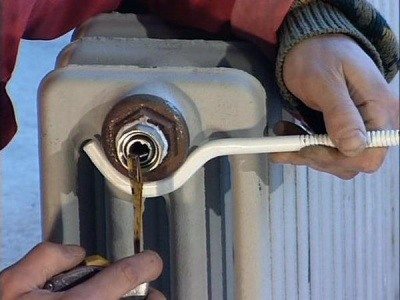

How to flush the heating system underfloor heating and how to flush the heating system in a private house with your own hands completely
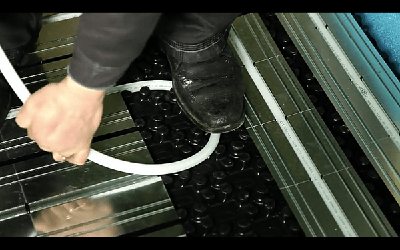

Installation of a water-heated floor without concrete screed
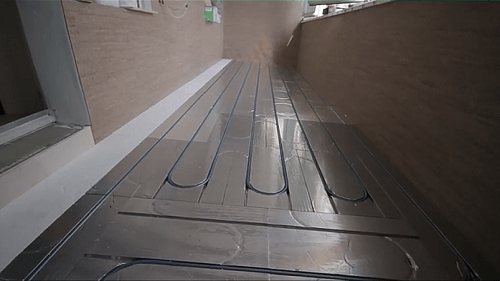

Technology of the underfloor heating system
We mount the water floor
In a private house, no one will forbid you to put a hydraulic underfloor heating. But you need to mount it with high quality, because comfort, safety, and the durability of the system itself, and savings depend on it.
Premises preparation
Any important business must begin with preparation, in this case, the premises:
- Mark the level of the top layer of your floor.
- Drill the holes for the pipes.
- Make tech niches.
- Prepare the subfloor - it must be leveled so that the skew does not exceed 5 °.
Thermal insulation
After the room is ready, it is necessary to install thermal insulation.
Foam, polyurethane and other similar materials are suitable for this. Best of all is a vapor barrier - for example, made of polystyrene.
The vapor barrier must be fixed and glued, for which a damper tape made of expanded polyethylene is used. It is attached around the perimeter and at the joints slightly above the screed. Then the heat insulator is laid - the mounting plate.
Pipe laying
A variety of pipes are used for underfloor heating:
- copper;
- steel;
- polyvinyl chloride;
- from metal-plastic;
- high strength polyethylene.
When laying pipes, you need to follow some rules:
- It is necessary to retreat 15 cm from the outer wall.
- Pipes must not be laid at the joints of floor panels.
- In the middle of the room, installation with a large pitch is possible.
As for the types of styling, there are several of them:
- snake;
- double snake;
- snail.
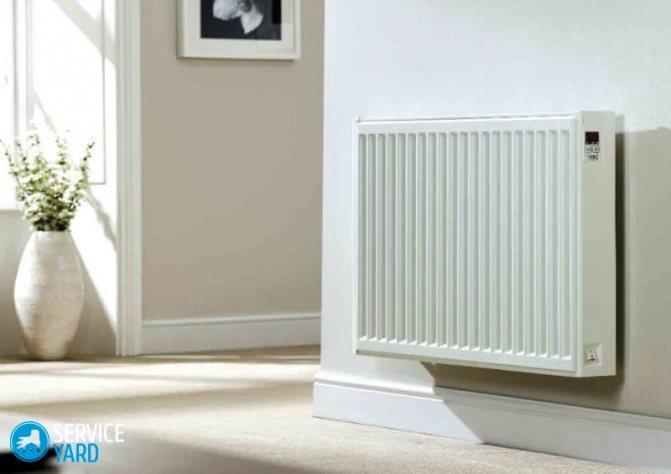

In addition to preparation and installation, the installation includes the following steps:
- connection to a distribution manifold;
- crimping;
- pouring with concrete;
- installation of an expansion joint.
The first option is for copper or polyethylene pipes, the second is for steel and metal-plastic. Pressure testing is carried out before pouring concrete, since at this stage the quality of the entire system is checked.
Without filling
Not so long ago, the so-called non-pouring hydraulic floor appeared. It is still not very popular, and its efficiency is lower, but it can be used in apartment buildings. It is much easier and faster to mount it:
- Thermal insulation is laid on the floor.
- A layer of chipboard or polystyrene boards is laid on top.
- The main layer is laid with heat-distributing plates.
- The plates are covered with a vibration-insulating layer.
- All this is covered with an outer layer, usually a laminate.
Preparation and commissioning
When setting up underfloor heating, a thermal head is used in the form of a conventional tap, which is installed for water supply and for reverse flow. Such a system is not assessed unambiguously:
- firstly, saving finances for the installation of the circuit is a plus;
- secondly, complications in operation, that is, frequent use of the thermal head disables it, an early replacement is required.
We recommend: How does an underfloor heating water heater work?
A convenient device is called a flow meter (or rotameter), which is installed near the collector at the circuit holes. Adjustment in this situation is the control of device readings (0.3 ... 0.5 liters).
The first start, done correctly, reveals weak points, malfunctions, possible malfunctions in the floor heating system.
Every year, with the onset of a cold snap, heating is started.

